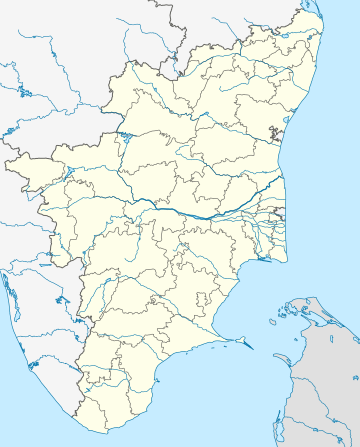Ashta Veeratta Stalam
Ashta Veeratta Stalam (also called Ashtaveertanam or Atta Veeratanam) are the eight temples of Hindu god Shiva, that commemorate his eight acts of valour and fury where he became victorious over demons or divinities.[1] Seven out of these temples are also classified as Paadal Petra Sthalam, the temples of Shiva that are revered in Tevaram (7th century canonical work by the Shaiva Nayanar saints).[2] The presiding deity in all the temples is called Veerateeswarar.
List of temples
Temple locations
| S.No. | Name of the temple | Location | Photo | Presiding deity and goddess | Commemorates |
|---|---|---|---|---|---|
| 1 | Veerateeswarar temple, Thirukovilur | Thirukovilur, Kallakurichi district Tamil Nadu 11°58′17″N 79°12′38″E / 11.97139°N 79.21056°E |
 |
Veerateeswarar and Periyanayagi | Shiva's slaying of the demon Andhakasura in the form of Andakasuramurthy.[3] |
| 2 | Veerateeswarar temple, Thiruvathigai | Thiruvathigai, Cuddalore Tamil Nadu 11°28′N 79°20′E / 11.46°N 79.33°E |
 |
Veerateeswarar and Mookambigai | Shiva's victory as Tripurantaka, destroyer of the three cities of the demon kingTripurasura or three demon brothers - collectively called as Tripurasura.[4][5][6] |
| 3 | Veerateeswarar temple, Korukkai | Korukkai, Mayiladuthurai district Tamil Nadu 11°09′19″N 79°36′43″E / 11.155340°N 79.611976°E |
 |
Veerateeswarar and Gnanambigai | Shiva's victory over the love god Kamadeva. Kamadeva tries to break Shiva's penance so that he can wake up and marry the goddess Parvati. The son of Shiva and Parvati is prophesied to slay the demon Tarakasura. Shiva awakens but in fury, burns Kamadeva by his third eye.[7][8][9][10] |
| 4 | Kandeeswarar Temple, Kandiyur | Thirukandiyur, Thanjavur district Tamil Nadu 10°51′36″N 79°6′30″E / 10.86000°N 79.10833°E |
 |
Kandeeswarar and Mangalanayagi | Shiva's form of Bhairava, who cut the fifth head of the god Brahma |
| 5 | Amritaghateswarar-Abirami Temple,Thirukkadaiyur | Thirukkadaiyur, Mayiladuthurai district Tamil Nadu 11°4′39″N 79°49′6″E / 11.07750°N 79.81833°E |
 |
Amritaghateswarar Abirami | Shiva's victory as Kalantaka (Conqueror over Time and Death) over the god of death Yama, to proper his devotee Markendeya from death.[11] |
| 6 | Veerateeswarar temple, Thirupariyalur | Thirupariyalur, Mayiladuthurai district Tamil Nadu 11°05′27″N 79°43′33″E / 11.090815°N 79.725804°E |
 |
Veerateeswarar and Ilam Kobanayal | Shiva's victory in the form of Virabhadra over the god Daksha and Destroyer of Daksha's sacrifice (Daksha yajna).[12] |
| 7 | Veerateeswarar temple, Vazhuvur | Vazhuvur, Mayiladuthurai district Tamil Nadu 11°02′42″N 79°38′16″E / 11.04501°N 79.6378°E |
 |
Veerateeswarar and Bala Gujambigai | Shiva's victory as Gajasamharamurti or "slayer of the elephant", where he killed the elephant demon.[13][14] |
| 8 | Veerateeswarar temple, Thiruvirkudi | Tiruvirkudi, Mayiladuthurai district Tamil Nadu 10°49′53″N 79°39′49″E / 10.831304°N 79.663743°E |
 |
Veerateeswarar and Elavar Kuzhali | Shiva's victory over the demon Jalandhara.[15] |
Notes
- ^ P., Karthigayan (2016). History of Medical and Spiritual Sciences of Siddhas of Tamil Nadu. Notion Press. p. 388. ISBN 9789352065523.
- ^ "Appar Tevaram -2" (PDF). Projectmadurai.org. pp. 14–6. Retrieved 16 July 2011.
- ^ "Slaying of Demon Andaka". Templenet. 2011. Retrieved 28 March 2016.
- ^ Krishna, Nanditha (2007). The Book of Demons. Penguin UK. p. 252. ISBN 9789351181446.
- ^ Madhavan 2014, p. 93
- ^ Kapoor, Subodh (2002). The Indian Encyclopaedia: La Behmen-Maheya. Genesis Publishing Pvt Ltd. p. 4467. ISBN 9788177552713.
- ^ Daniel Ingalls (1968). Sanskrit poetry, from Vidyākara's "Treasury". Harvard University Press. p. 58. ISBN 978-0-674-78865-7.
- ^ Klaus Klostermaier, (2000) Hinduism: A Short History. Oxford: One World Publications.
- ^ Wendy Doniger O'Flaherty, (1975) Hindu Myths: A Sourcebook Translated from the Sanskrit. London: Penguin Books, p.157-159 [1]
- ^ R. 2019, p. 129-33
- ^ V., Meena (1974). Temples in South India (1st ed.). Kanniyakumari: Harikumar Arts. p. 37.
- ^ R. 2019, p. 115-9
- ^ P. V. Jagadisa Ayyar (1920). South Indian shrines: illustrated. Madras Times Printing and Pub. Co. p. 281.
- ^ Tourist Guide to Tamil Nadu. Sura Books. 2010. p. 64. ISBN 978-81-7478-177-2.
- ^ R. 2019, p. 120-5
References
- Madhavan, Chithra (2007). Vishnu temples of South India volume 4. Chennai: Alpha Land Books Pvt. Ltd. ISBN 978-81-908445-3-6.
- R., Ponnammal (2019). 108 Thennaga Shivasthalangal (in Tamil). Giri Trading Agency Private Limited. ISBN 978-81-7950-707-0.

